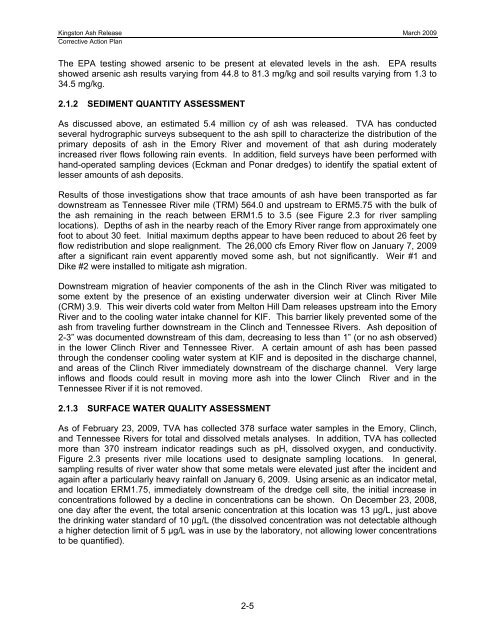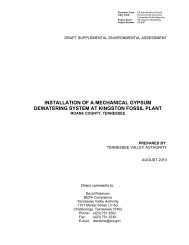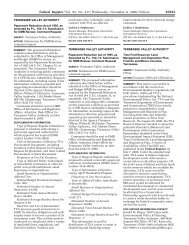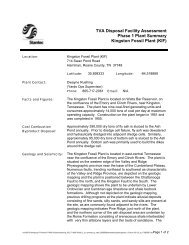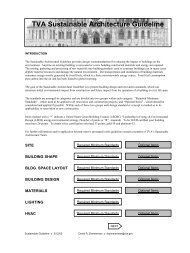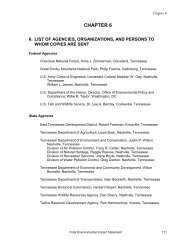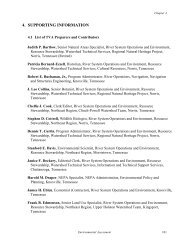Corrective Action Plan - Tennessee Valley Authority
Corrective Action Plan - Tennessee Valley Authority
Corrective Action Plan - Tennessee Valley Authority
Create successful ePaper yourself
Turn your PDF publications into a flip-book with our unique Google optimized e-Paper software.
Kingston Ash Release March 2009<br />
<strong>Corrective</strong> <strong>Action</strong> <strong>Plan</strong><br />
The EPA testing showed arsenic to be present at elevated levels in the ash. EPA results<br />
showed arsenic ash results varying from 44.8 to 81.3 mg/kg and soil results varying from 1.3 to<br />
34.5 mg/kg.<br />
2.1.2 SEDIMENT QUANTITY ASSESSMENT<br />
As discussed above, an estimated 5.4 million cy of ash was released. TVA has conducted<br />
several hydrographic surveys subsequent to the ash spill to characterize the distribution of the<br />
primary deposits of ash in the Emory River and movement of that ash during moderately<br />
increased river flows following rain events. In addition, field surveys have been performed with<br />
hand-operated sampling devices (Eckman and Ponar dredges) to identify the spatial extent of<br />
lesser amounts of ash deposits.<br />
Results of those investigations show that trace amounts of ash have been transported as far<br />
downstream as <strong>Tennessee</strong> River mile (TRM) 564.0 and upstream to ERM5.75 with the bulk of<br />
the ash remaining in the reach between ERM1.5 to 3.5 (see Figure 2.3 for river sampling<br />
locations). Depths of ash in the nearby reach of the Emory River range from approximately one<br />
foot to about 30 feet. Initial maximum depths appear to have been reduced to about 26 feet by<br />
flow redistribution and slope realignment. The 26,000 cfs Emory River flow on January 7, 2009<br />
after a significant rain event apparently moved some ash, but not significantly. Weir #1 and<br />
Dike #2 were installed to mitigate ash migration.<br />
Downstream migration of heavier components of the ash in the Clinch River was mitigated to<br />
some extent by the presence of an existing underwater diversion weir at Clinch River Mile<br />
(CRM) 3.9. This weir diverts cold water from Melton Hill Dam releases upstream into the Emory<br />
River and to the cooling water intake channel for KIF. This barrier likely prevented some of the<br />
ash from traveling further downstream in the Clinch and <strong>Tennessee</strong> Rivers. Ash deposition of<br />
2-3” was documented downstream of this dam, decreasing to less than 1” (or no ash observed)<br />
in the lower Clinch River and <strong>Tennessee</strong> River. A certain amount of ash has been passed<br />
through the condenser cooling water system at KIF and is deposited in the discharge channel,<br />
and areas of the Clinch River immediately downstream of the discharge channel. Very large<br />
inflows and floods could result in moving more ash into the lower Clinch River and in the<br />
<strong>Tennessee</strong> River if it is not removed.<br />
2.1.3 SURFACE WATER QUALITY ASSESSMENT<br />
As of February 23, 2009, TVA has collected 378 surface water samples in the Emory, Clinch,<br />
and <strong>Tennessee</strong> Rivers for total and dissolved metals analyses. In addition, TVA has collected<br />
more than 370 instream indicator readings such as pH, dissolved oxygen, and conductivity.<br />
Figure 2.3 presents river mile locations used to designate sampling locations. In general,<br />
sampling results of river water show that some metals were elevated just after the incident and<br />
again after a particularly heavy rainfall on January 6, 2009. Using arsenic as an indicator metal,<br />
and location ERM1.75, immediately downstream of the dredge cell site, the initial increase in<br />
concentrations followed by a decline in concentrations can be shown. On December 23, 2008,<br />
one day after the event, the total arsenic concentration at this location was 13 µg/L, just above<br />
the drinking water standard of 10 µg/L (the dissolved concentration was not detectable although<br />
a higher detection limit of 5 µg/L was in use by the laboratory, not allowing lower concentrations<br />
to be quantified).<br />
2-5


